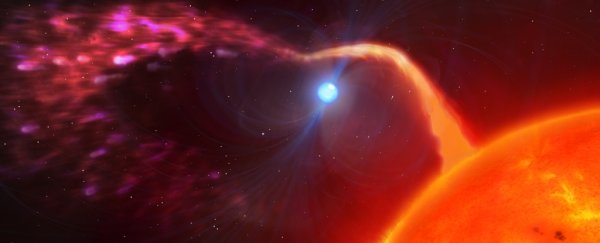A dead star is spinning so rapidly, it officially has the fastest known spin rate of any star of its kind.
It's a white dwarf star, named LAMOST J024048.51+195226.9 (J0240+1952 for short) and located 2,015 light-years away, and it has an insane rotation rate of just 25 seconds. That pips the previous record holder by a significant margin – CTCV J2056-3014, with a spin rate of 29 seconds.
It also bears a close similarity to another fast white dwarf, AE Aquarii, which has a spin rate of 33 seconds.
Both J0240+1952 and AE Aquarii are extremely special. They're the only two stars we've ever found belonging to a class of white dwarfs known as propeller stars.
Each star has a main sequence (hydrogen-fusing) binary companion, from which they are gravitationally stripping plasma. That plasma then gets flung out into space by the white dwarf's magnetic field, like a stream of water directed at a propeller.
For J0240+1952, so extreme is its tantrum that the plasma is getting flung out at speeds up to 3,000 kilometers (1,864 miles) per second.
"J0240+1952 will have completed several rotations in the short amount of time that people take to read about it, it is really incredible," says astrophysicist Ingrid Pelisoli of the University of Warwick in the UK.
"The rotation is so fast that the white dwarf must have an above average mass just to stay together and not be torn apart. It is pulling material from its companion star due to its gravitational effect, but as that gets closer to the white dwarf the magnetic field starts to dominate. This type of gas is highly conducting and picks up a lot of speed from this process, which propels it away from the star and out into space."
A white dwarf star is what happens to a star like the Sun when it runs out of elements it is able to fuse in its core. It ejects its outer material into space, and the core collapses into an ultra-dense object that shines incredibly brightly with residual heat.
These 'dead' stars are physically very small, around the size of Earth, but with masses up to around 1.4 times that of the Sun.
White dwarf stars often have binary companions in a close orbit – so close that they siphon, or accrete, material off the companion star, periodically erupting as the accreted material triggers runaway hydrogen fusion in the white dwarf's atmosphere, resulting in variations of its brightness.
These are known as cataclysmic variable stars. Eventually, the white dwarf may accrete so much mass that it becomes unstable and explodes in a spectacular Type Ia supernova.
J0240+1952 is a cataclysmic variable, and in the past it slurped up enough material from its red dwarf companion to give it a hefty rotation speed boost. But then, somehow, the white dwarf developed a magnetic field (astronomers think that the increased rotation rate of an accreting white dwarf might generate an internal dynamo, but we're still not sure).
This magnetic field acts as a barrier that repels the incoming plasma, flinging most out into space. A small amount does, however, still fall onto the white dwarf, where it flows towards the magnetic poles, causing a bright glow that allows astronomers to measure the star's rotation rate.
AE Aquarii's spin is slowing down at an unusually high rate, and the researchers want to see if the two systems exhibit the same behavior. If so, that will tell us a bit more about these rare and fascinating systems.
"It's only the second time that we have found one of these magnetic propeller systems, so we now know it's not a unique occurrence. It establishes that the magnetic propeller mechanism is a generic property that operates in these binaries, if the circumstances are right," says astrophysicist Tom Marsh from the University of Warwick.
"The second discovery is almost as important as the first as you develop a model for the first and with the second you can test it to see if that model works. This latest discovery has shown that the model works really well, it predicted that the star had to be spinning fast, and indeed it does."
The research has been published in the Monthly Notices of the Royal Astronomical Society: Letters.
